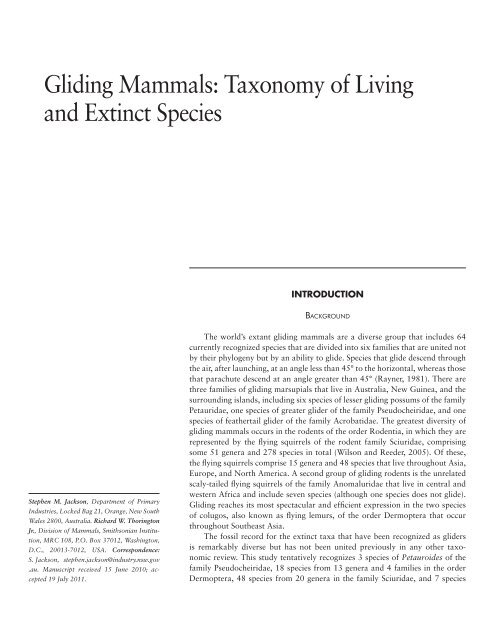Gliding Mammals: Taxonomy of Living and Extinct Species
Gliding Mammals: Taxonomy of Living and Extinct Species
Gliding Mammals: Taxonomy of Living and Extinct Species
You also want an ePaper? Increase the reach of your titles
YUMPU automatically turns print PDFs into web optimized ePapers that Google loves.
<strong>Gliding</strong> <strong>Mammals</strong>: <strong>Taxonomy</strong> <strong>of</strong> <strong>Living</strong><br />
<strong>and</strong> <strong>Extinct</strong> <strong>Species</strong><br />
Stephen M. Jackson, Department <strong>of</strong> Primary<br />
Industries, Locked Bag 21, Orange, New South<br />
Wales 2800, Australia. Richard W. Thorington<br />
Jr., Division <strong>of</strong> <strong>Mammals</strong>, Smithsonian Institution,<br />
MRC 108, P.O. Box 37012, Washington,<br />
D.C., 20013- 7012, USA. Correspondence:<br />
S. Jackson, stephen.jackson@industry.nsw.gov<br />
.au. Manuscript received 15 June 2010; accepted<br />
19 July 2011.<br />
INTRODUCTION<br />
Background<br />
The world’s extant gliding mammals are a diverse group that includes 64<br />
currently recognized species that are divided into six families that are united not<br />
by their phylogeny but by an ability to glide. <strong>Species</strong> that glide descend through<br />
the air, after launching, at an angle less than 45° to the horizontal, whereas those<br />
that parachute descend at an angle greater than 45° (Rayner, 1981). There are<br />
three families <strong>of</strong> gliding marsupials that live in Australia, New Guinea, <strong>and</strong> the<br />
surrounding isl<strong>and</strong>s, including six species <strong>of</strong> lesser gliding possums <strong>of</strong> the family<br />
Petauridae, one species <strong>of</strong> greater glider <strong>of</strong> the family Pseudocheiridae, <strong>and</strong> one<br />
species <strong>of</strong> feathertail glider <strong>of</strong> the family Acrobatidae. The greatest diversity <strong>of</strong><br />
gliding mammals occurs in the rodents <strong>of</strong> the order Rodentia, in which they are<br />
represented by the flying squirrels <strong>of</strong> the rodent family Sciuridae, comprising<br />
some 51 genera <strong>and</strong> 278 species in total (Wilson <strong>and</strong> Reeder, 2005). Of these,<br />
the flying squirrels comprise 15 genera <strong>and</strong> 48 species that live throughout Asia,<br />
Europe, <strong>and</strong> North America. A second group <strong>of</strong> gliding rodents is the unrelated<br />
scaly- tailed flying squirrels <strong>of</strong> the family Anomaluridae that live in central <strong>and</strong><br />
western Africa <strong>and</strong> include seven species (although one species does not glide).<br />
<strong>Gliding</strong> reaches its most spectacular <strong>and</strong> efficient expression in the two species<br />
<strong>of</strong> colugos, also known as flying lemurs, <strong>of</strong> the order Dermoptera that occur<br />
throughout Southeast Asia.<br />
The fossil record for the extinct taxa that have been recognized as gliders<br />
is remarkably diverse but has not been united previously in any other taxonomic<br />
review. This study tentatively recognizes 3 species <strong>of</strong> Petauroides <strong>of</strong> the<br />
family Pseudocheiridae, 18 species from 13 genera <strong>and</strong> 4 families in the order<br />
Dermoptera, 48 species from 20 genera in the family Sciuridae, <strong>and</strong> 7 species

















